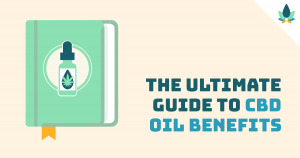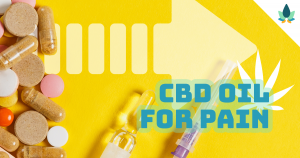Click To Find Out
If THC Is Legal In Your State
It feels like a simple question: where is marijuana legal in the United States?
Because the laws governing recreational and medical marijuana are complicated and change regularly, the answer to that question isn’t always so straightforward.
As it stands today, in as simple of an answer as is possible: 37 states along with the District of Columbia have legalized marijuana (containing THC) use in one way or another, with various restrictions and guidelines. (1)
Sound confusing? That’s okay. Read on to learn more about marijuana usage and restrictions across the country, then, check out our helpful map above for an even more in-depth look at the situation.
Recreational Marijuana Use
Washington D.C. and 18 other states currently have the most “open” laws for recreational marijuana and THC usage, with Connecticut being the most recent to adopt looser legislation.
These include:

- Alaska
- California
- Colorado
- Connecticut
- Illinois
- Maine
- Massachusetts
- Michigan
- Montana
- New Jersey
- New Mexico
- New York
- Nevada
- Oregon
- South Dakota
- Vermont
- Virginia
- Washington
For the most part, in these states, individuals over the age of 21 are permitted to purchase and/or possess marijuana for recreational use.
Occasionally, adults may even be able to grow a specific number of plants for personal use (click on an individual state in the map above for more detail).
Nineteen (19) other states allow for medical marijuana use (see below) – with a doctor’s prescription – under a very specific set of circumstances. These states may allow for the treatment of specific conditions (which vary from one state or another), for treatment in medical trials, or for the purchase of cannabis-infused products only, not marijuana itself.
In other areas of the country, certain states have taken steps to decriminalize the possession of a certain amount of marijuana, to introduce legislation that may legalize marijuana in the future, or, law enforcement has become more “lax” in dealing with first-time offenders.Medical Marijuana Use
States that allow for the medical use of marijuana, or for the treatment of specific medical conditions include:
- Alabama
- Alaska
- Arizona
- Arkansas
- California
- Colorado
- Connecticut
- Delaware
- Florida
- Hawaii
- Illinois
- Lousiana
- Maine
- Maryland
- Massachusetts
- Michigan
- Minnesota
- Missouri
- Montana
- Nevada
- New Hampshire
- New Jersey
- New Mexico
- New York
- North Dakota
- Ohio
- Oklahoma
- Oregon
- Pennsylvania
- Rhode Island
- Utah
- Vermont
- Virginia
- Washington
- Washington D.C.
- West Virginia
States Where Marijuana Use Is Still Completely Illegal
In some parts of the country, all recreational and medical cannabis is still illegal. These specific states include:
- Idaho
- Wyoming
- Nebraska
- Kansas
- Iowa
- Wisconsin
- Kentucky
- Tennessee
- Mississippi
- Georgia
- South Carolina
- North Carolina
While CBD oil – with specific restrictions (see our CBD legal piece), may be legal in a few of these states and is completely legal on a federal level under the 2018 Farm Bill, it’s important to understand the entire law before taking a risk or traveling to a given area with any form of the cannabis plant (including CBD products, low-THC products, or even prescription products approved by the FDA) – derived from either hemp or marijuana. Because some states also ban CBD containing any THC content (like Texas), gathering as much research as possible is critical.
Clearly: medical marijuana laws and cannabis laws are complex, complicated and changing constantly. It doesn’t help that DEA enforcement, federal law, FDA approved products and regulations often seem to conflict!

Federal Laws Governing Marijuana Use
To complicate the issue further, in most cases, federal laws and regulations differ from individual state laws.
This means that technically an individual using marijuana legally in a specific state could still be found in violation of federal law (in the legal state), may face penalties if returning to work in a non-legal state if they test positive for THC, or any other number of negative consequences.
According to official federal regulations, cannabis is considered a controlled substance, the same way more known drugs – like cocaine and heroin – are classified. Defined by the Controlled Substances Act, marijuana is a Schedule 1 drug, considered highly addictive with little to no medical value. (2)
Beginning in 2016, certain agencies, including the Department of Justice, have issued guidances and memorandums in an attempt to adjust to new state laws and regulations. In most cases, they have downplayed and de-prioritized marijuana law enforcement except to:

Prevent the distribution and sale of cannabis to minors.

Keep revenue from marijuana sales away from drug cartels and gangs.

Prevent marijuana from “legal” states from traveling to “illegal” states.

Prevent the mixing of firearms and the potential for violence and marijuana usage.

Prevent driving under the influence of marijuana.

Prevent possession and use on official, federal properties.
When legal action is pursued for those found in violation of federal laws, sentencing generally takes into account the amount of marijuana possessed or involved in the “crime” and the criminal history of the defendant. While each individual found to be in violation of federal law could be sentenced to imprisonment, it is not a current requirement.
How State-by-State Legalization of Marijuana Began: A Timeline
Marijuana’s pathway to state-by-state legalization has been a slow one. It has rapidly increased in trajectory lately, but, it all started with a single state’s decision to decriminalizing its use.

That state was Oregon. In 1973, Oregon reduced the penalty for the possession of up to one ounce of marijuana to a single $100 fine.

Over the next 15 years, about a dozen other states followed suit in various formats. Attitudes about the use of marijuana slowly began to relax. Still, the pathway to legalization was very hazy and several years away.

After decriminalization, marijuana slowly gained ground as an approved substance to treat specific medical conditions. California was the first state to approve medical marijuana usage for certain conditions – like epilepsy – in 1996. Arizona passed similar legislation that same year, however, it was overturned due to the wording.

By 1998, Oregon, Washington, Alaska and Washington D.C. each legalized medical marijuana with various restrictions. Starting in 2001, numerous other states began to do the same, as a “domino-effect” began.

Between 2001 and 2012, many states passed similar legislation. Some went back and forth a few times between medical marijuana being considered “legal” and “illegal,” and various laws relating to the prosecution of physicians for prescribing the substance were passed.

Then, in 2012, it happened. Colorado became the first state to legalize recreational marijuana use, by the popular vote of its residents. California followed shortly after in 2016.
Each of these landmark votes, along with the countless others that have taken place over the last two decades, have led to where we stand today.

The Path To Medical And Recreational Marijuana Legalization
Today, 10 states along with Washington D.C. have passed legislation legalizing the use of recreational marijuana.
Because of the numerous steps involved in the process, a vote to legalize the recreational use of marijuana does not allow for instant access to all residents. Often, laws require refining, dispensaries require approval, and other steps must take place before the first sale. This process can take several months to several years.
Take Massachusetts, for example. Voters in the state voted to legalize recreational marijuana in 2016, however, residents were not able to purchase it legally until November 20, 2018 due to the dispensary licensing process. (3)
As with other judicial and legal processes, the path to legalization has been a complex one. It takes considerable amounts of time and is still under fight in many states across the nation.
Why The Focus On New Legislation?
Now might be a good time to reflect on what brought us to this point in the first place, prior to the more recent legislative victories.
In the early days of the United States, marijuana was far from contraband. In fact, in the early 1600s, while colonization was taking place, hemp was considered a common currency, and in some places – namely Virginia – each farm was required to grow hemp along with other crops. (4)
Eventually, by the time the Civil War took place (long after cotton had replaced hemp as both currency and fabric), the medicinal effects of marijuana became more apparent. New tinctures and cures for a variety of ailments included the compound.
It’s popularity continued to increase… until the rise and fall of prohibition.
Those frustrated with the repeal of laws outlawing alcohol looked for other substances of concern. The new focus? Marijuana, which had grown in popularity in the previous few decades. Claiming ill effects on communities, a number of states banned marijuana individually, until, in 1937, the plant was outlawed on a national level.
By the time the War on Drugs began in the 1970s, marijuana was grouped with other street drugs. It was classified as dangerous and lacking medical value, leading to the complex legal situation our country finds itself in today: federal and state laws often conflict and regulations change at a rapid-fire pace, as described above. (5)
The Benefits of Marijuana Are Clear
Regardless of the hazy nature of today’s marijuana laws, one thing is certain: cannabis contains a variety of properties (including both THC and CBD) that make it a viable alternative to many traditional drug treatments for multiple conditions.
Patients suffering from epilepsy, multiple sclerosis, chronic pain, spinal cord injuries, lupus, nervous system damage, cancer, AIDS, arthritis, insomnia, irritable bowel syndrome, anxiety and a variety of other conditions have found varying levels of relief from marijuana.
While many of these benefits can also be achieved with CBD without the psychoactive effects of THC, marijuana is still a viable option for medicinal and recreational use, where permitted by law.
Where Does Your State Stand On Marijuana Use?
So. You understand the background. You understand the complexity of state laws vs. federal laws. You’re ready to move forward.
Great!
Take a look at the map above, and click on individual states to learn more about the legality of THC for both recreational and medicinal purposes in the United States.
Frustrated by your state’s lack of legalization? Visit the Marijuana Policy Project to make your voice heard… and remember, laws change regularly.







